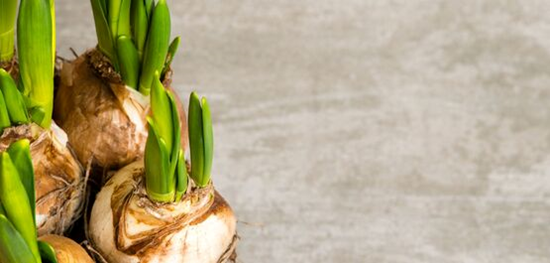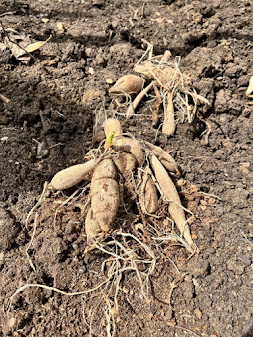Bulbs,
Corms, Tubers, and Rhizomes
Making Sense of the Storage Structures of Summer-Flowering Plants
When many
people think of bulbs, they think of spring flowering daffodils and tulips
planted in the fall. These are hardy bulbs left in the ground over the winter. However,
there are also summer flowering plants coming into bloom now and in the coming
months that utilize bulb and bulb-like structures.
Bulbs and
bulb-like structures can be put into categories including: true bulbs, corms,
tubers/tuberous roots, and rhizomes. A plant’s underground storage structure functions
to store nutrients for the plant. The plant can then access these nutrients
during times when it is not flowering, like during the winter, hot summers, and
droughts. Understanding the difference can help you better care for and
propagate your favorite plants.
Take note
that most summer-flowering bulbs are not hardy, they are planted in the spring
after the danger of frost has passed. In the fall when the leaves turn yellow,
most may be carefully dug up and stored in a frost-free location, like a garage.
Some bulbs can survive in the ground over a mild winter, but use a very heavy
layer of mulch for protection. Daylilies and iris are an exception as they are
hardy and can handle cold winters in the ground.
Specialized
storage organs, often referred to as bulbs.
Illustration and Caption
credit: University of Georgia Extension.
True
Bulbs:
A true
bulb comprises overlapping layers like an onion. It has a growing point at the
top and basal plate at the bottom where roots grow out of. Bulbs are planted
upright. The outside of a true bulb forms into “scales”. On tunicate bulbs, the
scales become dry and papery, serving as a protective layer around the bulb. On
non-tunicate bulbs, like a lily, the scales can break off from the basal plate.
Examples:
- Lilly
- Alliums
- Amaryllis
- Grape Hyacinth
Sprouting bulbs.
Photo credit: Cornell Cooperative Extension Rockland County
Corms:
A corm is
an underground solid stem enclosed by a dry outer covering. As with true bulbs,
this outer covering protects the inner layers. The plant grows from the top of
the corm. Corms only grow for one season, with new corms being produced. New
corms are called cormels.
Examples:
- Gladiolas
- Ranunculus
- Freesia
- Crocosmia
Photo Credit: Rutgers New Jersey Agricultural Experiment Station
Rhizomes:
A rhizome
is a specific kind of stem which grows near the surface of the soil. They can
be determinate or indeterminate, depending on whether or not they terminate in
a stem. For example, an iris is determinate because the rhizome produces one
stem, while Lilly-of-the-Valley is indeterminate because the rhizome produces
many shoots. Rhizomes are planted on their sides. You may be familiar with what
a ginger root looks like--it’s a rhizome.
Examples:
- Canna
- Iris
- Daylilies
- Kniphofia
- Agapanthus
- Calla Lilly
- Lilly of the Valley
- Trillium
- Liriope
Photo credit: UMass Amherst Extension
Iris
rhizomes.
Photo Credit: University of Maryland Extension
Tubers/Tuberous Roots:
Tubers are
underground, fleshy, modified stem tissue. A potato is a tuber. Tubers have
nodes or “eyes” capable of growing into a separate plant.
Tuberous
roots form from the swelling of roots near the base of the plant. They do not
have eyes and cannot regrow from root pieces. They lack nodes but can produce
buds near the stem.
Examples:
- Dahlia
- Begonia
- Caladium
- Elephant Ear
- Peony
at the Burlington County Agricultural Center.
References
and Additional Resources:
University
of Illinois Extension: “Bulbs”
https://extension.illinois.edu/flowers/bulbs
Rutgers
New Jersey Agricultural Experiment Station: “Spring Flowering Bulbs”
https://njaes.rutgers.edu/fs1220/
Rutgers
New Jersey Agricultural Experiment Station: “Cannas”, Fact Sheet 1155.
https://njaes.rutgers.edu/pubs/publication.php?pid=FS1155
Rutgers
New Jersey Agricultural Experiment Station: “Gladiolis murielae-Without
Doubt a Beautiful Flower”
https://njaes.rutgers.edu/plant-of-the-month/gladiolus.php
Penn State
Extension Chester County: “Bulbs, Corms, Rhizomes, and Tubers”
https://extension.psu.edu/programs/master-gardener/counties/chester/how-to-gardening-brochures/bulbs-corms-rhizomes-and-tubers
NC State
Extension: “Summer and Fall-Flowering Bulbs for the Landscape”
https://content.ces.ncsu.edu/summer-and-fall-flowering-bulbs-for-the-landscape
NC State
Extension: “Canna x generalis”
https://plants.ces.ncsu.edu/plants/canna-x-generalis/
University
of Georgia Extension: “Flowering Bulbs for Georgia Gardens”
https://extension.uga.edu/publications/detail.html?number=B918&title=flowering-bulbs-for-georgia-gardens
University
of Tennessee Agricultural Extension Service: “Flowering Bulbs for Tennessee
Gardens”
https://www.shelbycountytn.gov/DocumentCenter/View/1120/Flowering-Bulbs?bidId=





